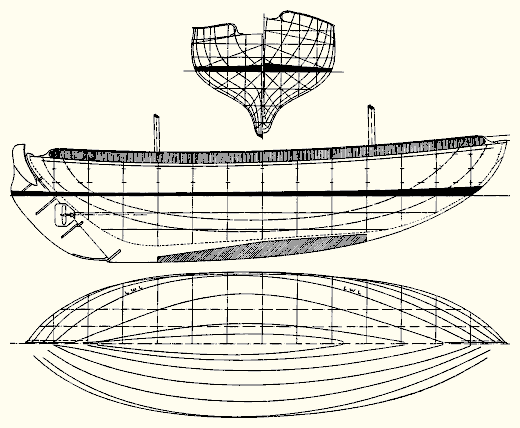

Here, Shipmates, is a big wholesome auxiliary designed for cruising, and especially for living aboard for long periods. Clione is her name -- after the astonishing little mollusk commonly known as the Sea Butterfly that spends its entire life on the water surface, never going ashore nor sinking to the sea's bottom. Our Clione is a double-ended ketch 34 feet 7 inches in overall length; 30 feet on the water line; 10 feet 4 inches in breadth; 4 feet 10 inches draft. Her freeboard at the bow is 3 feet 11 inches; at the stern 2 feet 11 inches; at the lowest point 2 feet 4 1/2 inches. Freeboard here is measured to the edge of the deck; bulwark rail and raised deck, of course, add considerably to this as shown on the profile drawings. The draft is somewhat under accepted practice in this matter; but I have found from usage that there is ample lateral plane to hold the boat on the wind, even under very difficult conditions. Long-legged hulls have their good points; but modest draft is good company, too. Less than 5 feet draft makes many harbors available, and contributes to easiness in rough water. The iron keel will weigh 6,500 pounds.

The ketch rig has a wide appeal among cruising men and many apparent advantages. Not least of these is the small units of sail and the ease of shortening sail without upsetting the balance of the sail plan. The yawl rig approaches this but has the disadvantage of a large mainsail. A gaff sail plan is used for economy, being far less expensive to make than the jib-head sail plan with its tall hollow masts, intricate standing rigging, spreaders, permanent back stays, mast winches, and other miscellaneous gear. If ever you are caught in very rough weather there will be comfort and assurance in those short masts and the simple standing rigging. Nothing is so far aloft that it cannot be reached in reasonable safety. Over a long period of time four-sided sails can be made to hold their shapes better than triangular sails, and being without wire luff ropes are easier to mend without special tools and equipment. There is a lot to be said for gaff-headed sails. The total sail area is 582 square feet distributed as follows: mainsail, 270 square feet; mizzen, 116 square feet; staysail, 90 square feet; and jib, 106 square feet. A useful and snug rig for short handed cruising.
Clione has a well deck forward and aft; a raised deck amidships. The after well contains the cockpit, this feet 3 inches long; 5 feet wide. The cockpit contains seats each side, the tops of which are considerably below the level of the deck. Thus one sits well down in the boat, rather than exposed and on the boat. The boomkin carries the traveller for the mizzen sheets; it is also handy as a platform when reefing the mizzen or furling sail. The raised deck is 15 feet 9 inches long, and, of course, extends the full width of the boat. Companionway, skylight and hatch provide entrance and ventilation to the cabin. The forward well deck takes care of bowsprit-heel knees, anchor winch, and staysail traveller.

Below deck Clione is laid out for the comfortable accommodation of a party of three, if short cruises are contemplated; but for two if a long voyage or living aboard is planned. The galley is aft; is 4 feet 4 inches long and extends the full width of the hull. Here are range, sink, lockers, ice box, dish shelves and lockers. A table over the ice box forms a useful chart table as shown. The main cabin is fitted with two box berths arranged to fold up against the yacht's sides, sofas, cabin table, lockers and so forth. The forward cabin contains a single pipe berth, seat, chain locker, water tank, and plenty of space to stow supplies and gear. The toilet room is big and properly fitted with pump closet and wash basin. There are large hanging lockers, 5 feet 4 inches in fore and aft length all together. Headroom throughout under the raised deck is a full six feet.

The motor of approximately 25 h.p. at about 1,200 r.p.m. is installed under the cockpit and is splayed off to port to clear the heel of the mizzen mast and also to be in a most efficient situation. The propeller shaft comes through the center of the stern post and is parallel with the water line.